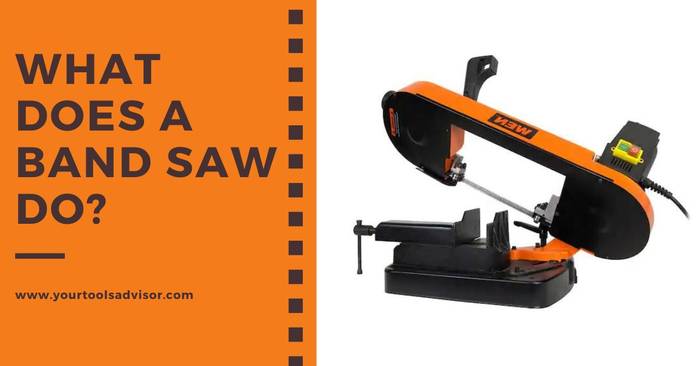A band saw is an essential tool in any workshop or construction site, as it allows for efficient and accurate cutting of different materials. Whether you are a professional woodworker, metalworker, or DIY enthusiast, a band saw can handle a wide range of cutting tasks.
It is a type of power tool that cuts various materials like wood, metal, or plastic with a continuous band of toothed metal. With its rotating blade, it provides precision and versatility in making straight or curved cuts.
Its blade, made of a continuous loop of teethed metal, rotates at high speed to create smooth and precise cuts. Whether it’s straight cuts, curves, or intricate designs, a band saw can handle them all. This versatile tool is suitable for cutting materials like wood, metal, plastic, and even frozen items.
With the ability to make tight curves, the band saw enables creativity and precision in various projects, making it an indispensable tool for any craftsman or hobbyist.
In this post, I am going to share a detailed discussion on what does a band saw do. If you don’t have any idea about a band saw or how it actually works, you can study the following discussion in order to get a precise idea about how this power tool works.
So, let’s get started…
Overview Of Band Saws
A band saw is an essential power tool for woodworkers, metalworkers, and other craftsmen. It is a versatile cutting tool that uses a blade with teeth to make precise cuts in various materials.
Band saws are widely used in workshops, construction sites, and manufacturing facilities due to their ability to handle intricate cutting tasks.
Read More:
Definition And Basic Function
A band saw is a powered saw that consists of a long, continuous band of toothed metal, typically stretched between two or more wheels. The saw blade moves in a continuous loop, and as the material to be cut is pushed into the blade, it cuts through it with precision and accuracy.
Unlike other types of saws, such as circular saws or jigsaws, band saws can cut irregular shapes and curved cuts smoothly.
With their large cutting capacity, band saws are commonly used for resawing thick boards, cutting lumber, metal, plastic, and even meats.
Types Of Band Saws
There are several types of band saws available, each designed for different applications:
- Vertical Band Saws: These band saws have a vertical orientation, with the blade moving up and down. They are commonly used for cutting intricate shapes and curves in wood and other materials.
- Horizontal Band Saws: Horizontal band saws have a horizontal orientation, with the blade moving in a fixed position. They are primarily used for straight cuts and are often used for cutting metal and pipes.
- Benchtop Band Saws: These compact band saws are designed to be mounted on a workbench or table. They are ideal for small cutting tasks and are frequently used by hobbyists or DIY enthusiasts.
- Cutting Band Saws: These industrial-grade band saws are specifically designed for heavy-duty cutting tasks in factories or manufacturing facilities. They have a larger cutting capacity and can handle thicker materials with ease.
Importance And Versatility
Band saws are crucial tools in the woodworking and metalworking industries due to their importance and versatility.
Here’s why:
- Precision Cuts: Band saws excel at making accurate and intricate cuts, allowing craftsmen to create intricate designs and shapes.
- Curved Cuts: With their thin blades and ability to cut in different directions, band saws are perfect for creating curved cuts that other saws may struggle with.
- Resawing Capability: Resawing is the process of cutting a piece of wood into thinner pieces. Band saws are well-suited for this task, providing consistent and smooth results.
- Material Versatility: Band saws can cut through a wide range of materials, including wood, metal, plastics, and even bone. This makes them highly versatile and essential for various industries.
- Efficiency and Speed: Band saws are designed to be efficient and time-saving. Their continuous cutting action allows for faster cutting compared to other saws.
- Precision Control: Band saws offer precise control over the cutting process, enabling craftsmen to achieve desired shapes and sizes with ease.
Components Of A Band Saw
When it comes to woodworking, a band saw is an essential tool that provides versatility and precision in cutting wood and other materials. To understand the workings of a band saw, it is crucial to be familiar with its key components.
In the following discussion, we will explore the main Components of a Band Saw: the blade, frame, table, and motor.
By gaining a deeper understanding of these components, you can maximize the efficiency and effectiveness of your woodworking projects.
Blade
The blade is the heart of a band saw. It is a continuous band of toothed metal that rotates around two or more wheels, allowing for precise cutting. Band saw blades come in various widths, lengths, and tooth configurations, depending on the type of material and the type of cut desired.
The blade’s teeth can have different tooth patterns, such as hook, skip, or regular, to accommodate different cutting requirements. Choosing the right blade for your specific project is essential for achieving clean and accurate cuts.
Frame
The frame of a band saw provides the structure and support for all the other components. It is typically made of cast iron or steel, ensuring stability and durability. The frame houses the wheel assembly, motor, and blade guides. A robust frame design helps reduce vibrations, ensuring smooth and precise cuts.
Additionally, the frame also houses the tensioning mechanism, which allows you to adjust the tension of the blade to achieve optimal cutting performance.
Table
The table of a band saw functions as a working surface for your materials. It is a flat and adjustable platform that supports the material being cut. Band saw tables can be tilted to various angles, allowing for bevel and compound cuts.
The table usually features a miter gauge slot, which enables you to make accurate crosscuts by using a miter gauge or other accessories. Some band saws also come with extensions for larger workpieces, providing additional support and stability during cutting operations.
Motor
The motor is the power source of a band saw. It drives the rotation of the wheels and subsequently the blade. Band saw motors can be electric or hydraulic, depending on the type and size of the saw. Electric motors are the most common and provide reliable and consistent power.
The power of the motor is measured in horsepower (HP), with higher horsepower motors offering greater cutting capacity and versatility.
A well-powered motor ensures smooth blade operation and efficient cutting, even when dealing with dense or thick materials.
What Does A Band Saw Do?
A band saw is a versatile power tool used to make intricate and precise cuts in a variety of materials such as wood, metal, and plastic. It consists of a continuous band of teeth or blades wrapped around two or more wheels.
One wheel acts as a driver while the other serves as an idler. Understanding the inner workings of a band saw can help you make the most of this indispensable tool.
Cutting Process
The cutting process of a band saw involves the rotation of the band’s blades or teeth as they pass through the material being cut. The blade tension and tracking are crucial elements that affect the performance and accuracy of the band saw.
Blade Tensioning And Tracking
The proper tensioning of the band saw blade is essential for optimal cutting. The tension is adjusted by tightening or loosening the tension knob or lever located on the band saw. This adjustment ensures that the blade is stretched to the correct tension, preventing it from slipping or coming off during operation.
Tracking, on the other hand, refers to the alignment of the blade on the wheels. If the blade is not properly aligned, it may drift off course, resulting in uneven cuts. To adjust the tracking, there are usually control knobs or tracking screws provided on the band saw.
By turning these knobs or screws, you can align the blade properly, ensuring it stays on track.
Adjusting The Cutting Speed
The cutting speed of a band saw can be adjusted to suit the material being cut. Different materials require different cutting speeds to achieve optimal results. Typically, band saws feature a pulley system that allows you to change the speed by adjusting the position of the drive belt.
Lower speeds are suitable for cutting denser materials like metal, while higher speeds work well for softer materials like wood.
When adjusting the cutting speed, it is important to follow the manufacturer’s recommendations for the specific material you are working with. This ensures that you achieve clean cuts without causing damage to the band saw or the material itself.
By understanding the cutting process, blade tensioning, tracking, and adjusting the cutting speed, you can harness the full potential of a band saw. This versatile tool enables you to make precise and intricate cuts, making it an invaluable addition to any workshop or project.
Common Uses Of Band Saws
Band saws are versatile power tools that find applications in various industries and projects. From woodworking to metalworking, and even home improvement and DIY projects, these tools have proven their worth in countless applications.
Let’s explore how band saws are commonly used in different fields…
Woodworking Projects
When it comes to woodworking, band saws are essential tools that provide precision and efficiency. Whether you are cutting curves, resawing lumber, or creating intricate shapes, a band saw is a go-to option for woodworkers. Its unique design and compatibility with various blades allow for intricate and detailed cuts that would be challenging to achieve with other tools.
With a band saw, you can effortlessly create smooth curves, rip boards, and even cut dovetails. It is widely used for making veneer, shaping furniture parts, and creating intricate designs on wood pieces.
Woodworkers often rely on band saws for both small-scale projects, such as crafting wooden toys, and larger-scale endeavors, such as building cabinets.
Metalworking Applications
If you delve into the world of metalworking, you’ll find that band saws are invaluable tools for shaping and cutting metal with precision. Due to their strength and versatility, these power tools are frequently used in various metalworking applications.
With the appropriate blade, a band saw can slice through bars, tubes, and pipes made of different metals, including steel, aluminum, and brass. From preparing metal stock to fabricating intricate pieces, band saws play a critical role in metalworking.
Whether you are a hobbyist creating metal sculptures or a professional fabricating machine parts, a band saw will help you make accurate cuts and achieve the desired results.
Home Improvement And DIY Projects
Band saws are not limited to professional settings. They also offer immense value in home improvement and DIY projects. From building shelves to making custom furniture and renovating your home, a band saw can prove to be an indispensable tool.
With a band saw, you can tackle a wide array of projects, including but not limited to cutting trim, making precise crosscuts, or creating unique shapes for cabinets and other furniture pieces. It enables you to effortlessly complete DIY projects, personalize your home decor, and bring your creative ideas to life.
Moreover, band saws are perfect for hobbyists who enjoy woodworking, metalworking, or crafting. Whether you are a DIY enthusiast or a professional contractor, having a band saw in your workshop can greatly enhance your capabilities and expand the scope of projects you can undertake.
Safety Tips For Using A Band Saw
When it comes to working with a band saw, prioritizing safety is of utmost importance. Band saws are powerful tools that can cut through various materials with precision, but they can also pose potential hazards if not used properly.
Wearing the right protective gear is crucial when operating a band saw. It is recommended to use the following equipment for maximum safety:
- Safety glasses or goggles: Protect your eyes from flying debris, especially when cutting materials that may generate sparks or splinters.
- Ear protection: Band saws can produce loud noise, which can be damaging to your hearing. Use earplugs or earmuffs to reduce the risk of noise-induced hearing loss.
- Gloves: Select gloves that allow proper dexterity and provide a good grip on the material being cut. Avoid loose-fitting gloves that may get caught in the blade.
- Dust mask or respirator: Cutting materials may release harmful dust or particles into the air. Wear a dust mask or respirator to protect your lungs from inhaling these particles.
- Protective clothing: Wear snug-fitting clothing that covers your arms and legs, as loose clothing may get entangled in the machine. Avoid wearing jewelry or loose accessories.
- Safety footwear: Choose footwear with a slip-resistant sole and sturdy construction to protect your feet from falling objects or accidental slips.
Read More: Where Do You Buy Band Saw Blades From?
FAQs On What Does A Band Saw Do
What Is A Band Saw Good For?
A band saw is a versatile tool suited for cutting various materials. Its thin, continuous blade allows for straight or curved cuts in wood, metal, and plastics.
It is great for precision cuts and intricate designs, making it ideal for woodworking, metalworking, and even hobby projects.
What Is The Most Common Use For A Band Saw?
A band saw is most commonly used for precise cutting of curves and irregular shapes in various materials such as wood, metal, and plastic.
It offers versatility in woodworking, metalworking, and other industries, making it an essential tool for craftsmen and professionals.
Why Use Band Saw Instead Of Table Saw?
The band saw is preferred over the table saw due to its versatility, ability to cut complex shapes, and suitability for resawing. Additionally, it allows for more precise cuts, works well with thick materials, and reduces waste.
Ultimately, the band saw offers a wider range of uses compared to the table saw.
Do I Really Need A Band Saw?
Yes, a band saw is a valuable tool for various woodworking tasks. It allows for precise and straight cuts, curving shapes, and resawing large pieces of wood. It offers versatility and efficiency in a woodworking workshop.
Conclusion
Band saws are versatile and efficient tools that are widely used in various industries. From cutting curves and irregular shapes to ripping lumber and resawing boards, band saws offer precision and accuracy in cutting different materials.
With their adjustable blades and powerful motors, band saws provide a reliable and effective solution for woodworkers, metalworkers, and DIY enthusiasts alike.
Investing in a band saw can greatly enhance your cutting capabilities and productivity in your projects. Experience the benefits of a band saw and unleash your creativity with this essential tool.





Leave a Reply